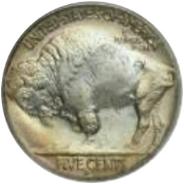The 1937 Three Legged Buffalo Nickel is perhaps the
most famous error coins ever created, and it is a highly desirable coin
for all collectors. It gets its name from the fact that the reverse side
of the coin depicts a buffalo that appears to only have three legs. This
unusual mint error has fascinated collectors for years and it has become
one of the most sought-after and famous coins in the 20th century.
The error was made when a Denver Mint employee, just recently hired, was
attempting to remove some die marks from one of the reverse dies. He was
able to successfully remove the marks, but he also inadvertently erased
one of the buffalo’s legs. This blunder was not caught until most of the
coins had already gone into circulation.
Both major grading systems, NGC and
PCGS, identify this particular coin by
including the words “3 Legs” on the Three Legged Buffalo Nickel. These are
in high demand regardless of grade, but are especially popular in
mint-state. There have been approximately 20 coins that have been graded
MS66, and two have been graded MS67 by NGC. (This grading means that they
are in near perfect shape; i.e. ‘mint condition.’) Coins with this grade
can easily be sold for at least $50,000. In 2007, an auction was held
which saw one of the coins be purchased for a price of $80,500.
In order to make sure you are getting a genuine error coin, as opposed to
an altered one, there are certain things to look for. The buffalo is
smaller on a genuine coin, and larger on an altered coin. This is quite
visible to the naked eye upon comparison. Also, the back legs on the
genuine coin are narrow and look ‘bumpy.’ They are not completely rounded.
The beard tips are even and blunt on the genuine coin. The “P” in Pluribus
and the “U” in Unum do not touch the Buffalo, as they do in altered or
counterfeit coins. Also the rear leg on the Buffalo is weak – the altered
version has strong details on the hind leg.
If you order the Three Legged Buffalo Nickel from a reputable dealer, they
will check to ensure that it is a genuine artifact, not an altered one.
PCGS, for instance, will guarantee the authenticity and grade of the coin.
Unfortunately, there are some disingenuous dealers who may try to sell you
an altered coin. It’s important to know the subtle differences so that you
can make an informed decision about your purchases.
The Buffalo coin first came into production on March 4, 1913. James Earle
Fraser, a reputable and famous sculptor of the time, learned that the Mint
was considering a replacement for the Liberty Nickel. He wrote a letter to
them in 1911, suggesting that a Native Indian and a Buffalo on the same
coin was a purely American idea. His lobbying paid off, and his vision
became a reality. After its debut in 1913, they continued to be in
production on an intermittent basis. None of these coins were made in
1922, 1932 or 1933. The last of these coins were minted in 1938, one year
after the famous error coin went into production. You may also here these
coins called Indian Head nickels.
There is an act in Congress that was recently passed that required the
word COPY to appear on all reproductions. This was done in the hopes that
collectors will be alerted when non-genuine coins are trying to be passed
as genuine.
The mint error made by the new employee at the Denver Mint was no doubt
fired for his blunder; but it has certainly created fame and fortune for
collectors who have spent years trying to track down this error coin and
either keep it for their own, or sell it for a profit. The value of these
coins will of course depend on their condition and whether or not they’ve
been in circulation. The grading companies, such as NGC and PGCS assign
grades to all coins, and one of the considerations when they assign a
grade is what kind of shape the coin is in. The value can range from a few
dollars to tens of thousands of dollars.
|
Among the many key diagnostics to look
for on a genuine coin are these:
Obverse: Rust pits, flaws, and die crack. Although few of the
references mention it, this issue always shows patches of roughness on the
obverse, apparently created from die rust. One patch is on the top of the
Indian's neck, just below the juncture with the hair. Another shows to the
left of the longest feather about midway down, in the hair. Other patches
are just above the obverse rim at 6 o'clock, and on the front of the neck,
beneath the jawline. A small die crack runs southeast through this patch,
with a small, comma-shaped lump near its lowest point.
Reverse: Beard, hoof and leg, die lumps, spindly rear leg. The
reverse of a genuine 1937-D Three-Legged Buffalo also has numerous
diagnostics that are easy to spot. The buffalo's beard is pointed, and
longer on the right (facing) side than the left. Although a Mint employee
removed the front leg with an emery board, the hoof is still present.
There is a stream of raised die lumps running downward between the front
and rear legs. |

